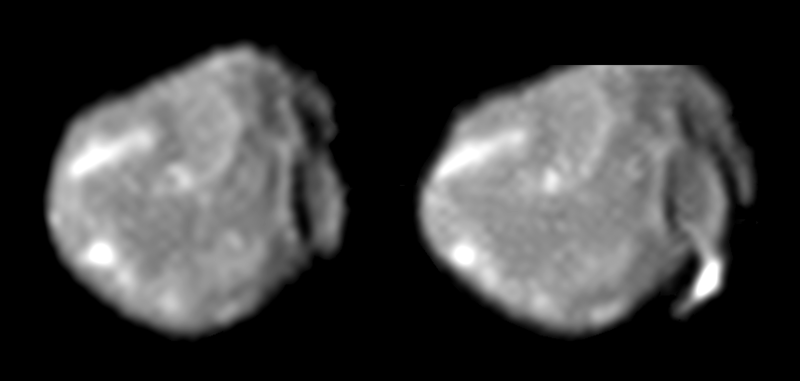 (Image from Wikipedia; full article here) At 83 km in diameter (~50 mi), Amalthea was the fifth discovered moon of Jupiter (the first four were the large Galilean satellites), and the last planetary satellite to be discovered by direct visual observation, as opposed to photographically. Given that the above Galileo images are among the highest quality available, it should be unsurprising not too much is known about this object. A couple of seemingly unrelated facts do constrain its history, though. First, Jupiter would loom in the sky, covering more than 45 degrees of arc; in other words, if you drew a horizon-to-horizon line, Jupiter would cover more than quarter of that. Second, recent observations strongly indicate that Amalthea is icy. Since the young planet was very hot, we can conclude Amalthea did not form where it is today. It either migrated from a more distant orbit, or was captured by Jupiter later in its history.
(Image from Wikipedia; full article here) At 83 km in diameter (~50 mi), Amalthea was the fifth discovered moon of Jupiter (the first four were the large Galilean satellites), and the last planetary satellite to be discovered by direct visual observation, as opposed to photographically. Given that the above Galileo images are among the highest quality available, it should be unsurprising not too much is known about this object. A couple of seemingly unrelated facts do constrain its history, though. First, Jupiter would loom in the sky, covering more than 45 degrees of arc; in other words, if you drew a horizon-to-horizon line, Jupiter would cover more than quarter of that. Second, recent observations strongly indicate that Amalthea is icy. Since the young planet was very hot, we can conclude Amalthea did not form where it is today. It either migrated from a more distant orbit, or was captured by Jupiter later in its history.
Miscellaneous thoughts on politics, people, math, science and other cool (if sometimes frustrating) stuff from somewhere near my favorite coffee shop.
Monday, June 27, 2011
Moonday: Amalthea
 (Image from Wikipedia; full article here) At 83 km in diameter (~50 mi), Amalthea was the fifth discovered moon of Jupiter (the first four were the large Galilean satellites), and the last planetary satellite to be discovered by direct visual observation, as opposed to photographically. Given that the above Galileo images are among the highest quality available, it should be unsurprising not too much is known about this object. A couple of seemingly unrelated facts do constrain its history, though. First, Jupiter would loom in the sky, covering more than 45 degrees of arc; in other words, if you drew a horizon-to-horizon line, Jupiter would cover more than quarter of that. Second, recent observations strongly indicate that Amalthea is icy. Since the young planet was very hot, we can conclude Amalthea did not form where it is today. It either migrated from a more distant orbit, or was captured by Jupiter later in its history.
(Image from Wikipedia; full article here) At 83 km in diameter (~50 mi), Amalthea was the fifth discovered moon of Jupiter (the first four were the large Galilean satellites), and the last planetary satellite to be discovered by direct visual observation, as opposed to photographically. Given that the above Galileo images are among the highest quality available, it should be unsurprising not too much is known about this object. A couple of seemingly unrelated facts do constrain its history, though. First, Jupiter would loom in the sky, covering more than 45 degrees of arc; in other words, if you drew a horizon-to-horizon line, Jupiter would cover more than quarter of that. Second, recent observations strongly indicate that Amalthea is icy. Since the young planet was very hot, we can conclude Amalthea did not form where it is today. It either migrated from a more distant orbit, or was captured by Jupiter later in its history.
I didn't know that Amalthea is icy. Very good information. Which telescope has made the photograph?
ReplyDeleteAll the best,
Gerard
stereopair!
ReplyDelete